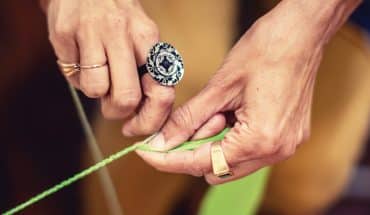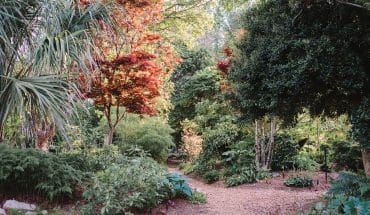by Lori D.R. Wiggins | photography by Bob Karp

When architect Victor Gruen built the first shopping center more than a half-century ago, he’d envisioned its role in commerce, yet dreamed of its function in the future as a sort of suburban town square. Malls, he believed, could be a place where people would meet and gather to socialize in celebration and for recreation.
A few decades later, it seems Gruen’s dream has come true: Findings show malls are second only to neighborhoods as the most popular place to walk, according to Mall Walking: A Program Resource Guide by the University of Washington Health Promotion Research Center and the Centers for Disease Control and Prevention. That’s right: These malls are made for walking.
Just ask Mickey Pleasants and Vicky Langley. Together, they’ve walked the stretches between Crabtree Valley Mall’s anchor stores for 33 years. Ten years ago, Lorraine Phillips and Jayne VanGraafeiland turned their duo to four. “We were hoping to lose weight—and we still do, hope to lose weight,” Langley snickers. “But we really do it for the exercise, and we enjoy each other’s company. Mickey would fuss at me if I didn’t
show up. That keeps you going; keeps you honest. It’s simple, says Pleasants. “We expect each other to be there, so we show up. It’s a good form of exercise—and we can solve the world’s problems while we walk.” Plus, she quips, “What’s said in the mall, stays in the mall, so we can say anything!”
They’ve seen stores come, go and move around. People, too. “Even if we don’t know their names,” Phillips says, “we know everyone’s faces.” They also know that Crabtree Santas don’t carry those jolly bellies for lack of exercise; they mall-walk, too! The group notices stores unpack new shipments, earning first dibs to critique what’s hot or not in fashion. They’ve watched a fellow mall walker’s grandson grow from newborn to toddler; he recently celebrated his birthday party in the mall, surrounded by mall walkers.

Every step they take is a link to Americans living longer and faring better. Wellness experts agree that walking can lower blood pressure, prevent and treat Type II diabetes, and decrease stress; improve balance, coordination, cardiovascular health, muscle tone and mental acuity; reduce risks of falls, osteoporosis, stroke and heart attack; and promote sleep. For older adults, that means well-oiled joints and greater independence, punctuated by boosts in mood, energy and calories burned. Walking the mall is excuse-and barrier-free fitness, the mall walking guide emphasizes. It’s self-paced exercise in a secure, well-lit place with level, pre-measured walking routes (in Crabtree, twice around, plus the wings, is a mile)that are also close to bathrooms, benches and water fountains. It’s also free, and the weather is always perfect.
“It’s a great social outlet,” says VanGraafeiland. “We wouldn’t miss it for anything.” But, she cautions, mall walks aren’t shopping trips. “We go. We walk. We leave,” she says. The only exceptions happen around the holidays, when stores open early. “We walk and then do our Christmas shopping when there’s hardly anybody in there,” says Phillips. “That works out great.”Cathy Monaghan and Beth Tefft taught school together and now, retired, mall-walk together. “We’ve met all kinds of interesting people, and it’s just been a very positive atmosphere,” says Monaghan. “I’m probably a little addicted, to be perfectly honest.” Tefft agrees, saying, “It’s really kind of a community.” When the mall discontinued the coffee breaks it once offered mall walkers, featuring pastries or bagels and sometimes speakers, the walkers started their own, filling tables at Panera Bread after their walks. “We almost always have a coffee club now,” says Harvey Davis. “We do that every day.”

Once a week at Crabtree, a group of about 25 people gather to practice Taoist Tai Chi. “It’s walking meditation,” says Stephanie Farmer, who began practicing the Chinese martial art 20 years ago with her husband, Bob, a former teacher to many in the group. “We were inspired by the mall walkers,” he says. “We’re just enjoying Tai Chi like people often do in the park.”
Like Crabtree, Triangle Town Center and Cary Towne Center have their own unique exercise and social culture in the early mall-walking hours. Everywhere, though, older adults dominate. “It can be a good thing, for sure,” says Triangle spokeswoman Laura Gipple. “We enjoy having them.” Doc Dickinson walks about 3 ½ miles at Triangle nearly every day. “I’m motivated by fear,” he says, since he had two heart procedures years ago. “And my cardiology nurse kicks my butt if I don’t do it.” Mall walking is “informal and very congenial,” Dickinson says. “It’s like a Model U.N.,” with walkers of all races and religions, whose mutual support even extends into giving greeting cards of care and cheer signed by them all. That’s community, he says. Or, “like a second family,” says Angie Martin, whose walks at Triangle began in 2003. “I didn’t want to walk by myself,” says Martin. “That’s why I started going, and that’s what keeps me going.” Gruen, dubbed the Mall Maker, thought so. In his book, Shopping Towns USA: The Planning of Shopping Centers, he wrote, “The shopping center which can do more than fulfill practical shopping needs, the one that will afford an opportunity for cultural, social, civic and recreational activities, will reap the greatest benefits.” And so will the people who walk it.



